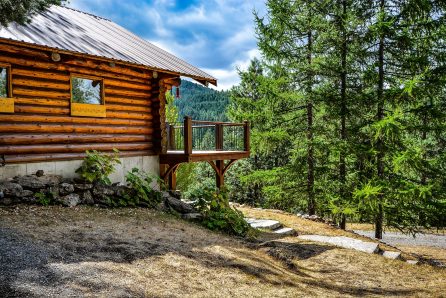Herb gardens date back to ancient civilizations where herbs were used for medicinal purposes, seasoning and fragrance. Egyptian schools of herbalists existed thousands of years ago. Herbs are mentioned in the Old Testament of the Bible. Pioneers had an herb garden next to their log cabins when they settled in early America. So should you.
Herb gardening makes for a great hobby at the cabin! Additionally, herb gardens are a great addition to any log cabin home. They can be as small as a window box outside your kitchen or have a designated space within your landscaping. Even if you don’t have a green thumb, you can manage an herb garden.
Herb Gardening at the Cabin
 Planting Your Herb Garden
Planting Your Herb Garden
When selecting where to place your herb garden, consider that most herbs prefer at least four to six hours of sun per day. Loosen any compacted soil before you plant. This will allow for proper drainage and root growth. Position herbs according to the growing conditions they prefer. Lavender is fine with drier conditions while Basil thrives in moister conditions.
Make sure to regularly water newly planted herbs. It’ time to water when the soil feels dry.
Don’t forget to label your herbs so you don’t confuse them. No one wants mint in their marinara by accident.
Harvesting Your Herbs
As soon as the herbs reach maturity, you can harvest. Generally, snip about one third of the branch. Lavender can be cut at ground level. Snip regularly so your herbs continue to grow. The best time of day to harvest is in the morning.
Storing Herbs
To store your freshly snipped herbs, loosely wrap them in a damp paper towel and place in an air filled, sealed plastic bag. They should keep in the refrigerator for up to five days. Use quickly, because they will start to lose their flavor after a few days.
Drying Herbs
To dry your freshly harvested herbs, gather them in small bunches, tie together tightly and hang to dry. Be patient, this process can take up to three weeks. Strip dried leaves off before storing in airtight containers away from heat and light.
Popular Herbs and Yummy Recipes
Basil is incredibly versatile and used in many types of food including a spicy Thai Stir-Fry or Italian Pesto . Basil is aromatic with a slightly sweet flavor.
Cilantro’s slightly citrus flavor is best appreciated fresh. Some people report that cilantro tastes like soap. This is because they are able to pick up the smell of aldehyde chemicals found in cilantro and soap. Except for this minority of the population, no salsa recipe is complete without cilantro.

Lavender Lemonade
Lavender is a nice addition to any garden because bees and butterflies like it but deer and rabbits avoid it. It’s not just for soap and potpourri. Lavender Lemonade is a refreshing thirst quencher.
Mint has a history of treating gastrointestinal ailments and can be used in recipes from ice cream to jelly to cocktails. Mojitos, made with muddled mint and lime, are a great adult beverage to cool off with on a hot summer day on your log cabin’s front porch.
Oregano has a slightly lemony aroma and flavor. It is often used in Mediterranean and Mexican cuisine such as tomato sauce, soups, herbed breads and vinaigrettes vinaigrettes .
Rosemary looks like a small Christmas tree branch and has a piney scent and strong flavor. The stems make great skewers for kebabs. It’s a flavorful addition to meats, rustic breads and vegetables. Rosemary Potatoes can be cooked traditionally in an oven or in foil over a campfire next to your log cabin.
Sage is best known in America in Thanksgiving stuffing and breakfast sausage. It is very aromatic with a slightly bitter, woody taste. It can be overpowering.
Tarragon is deer resistant with a scent reminiscent of licorice. It is a staple in French cooking and pairs well with poultry, fish, vegetables, eggs and cream sauces cream sauce .
Have you tried your hand at herb gardening yet?
